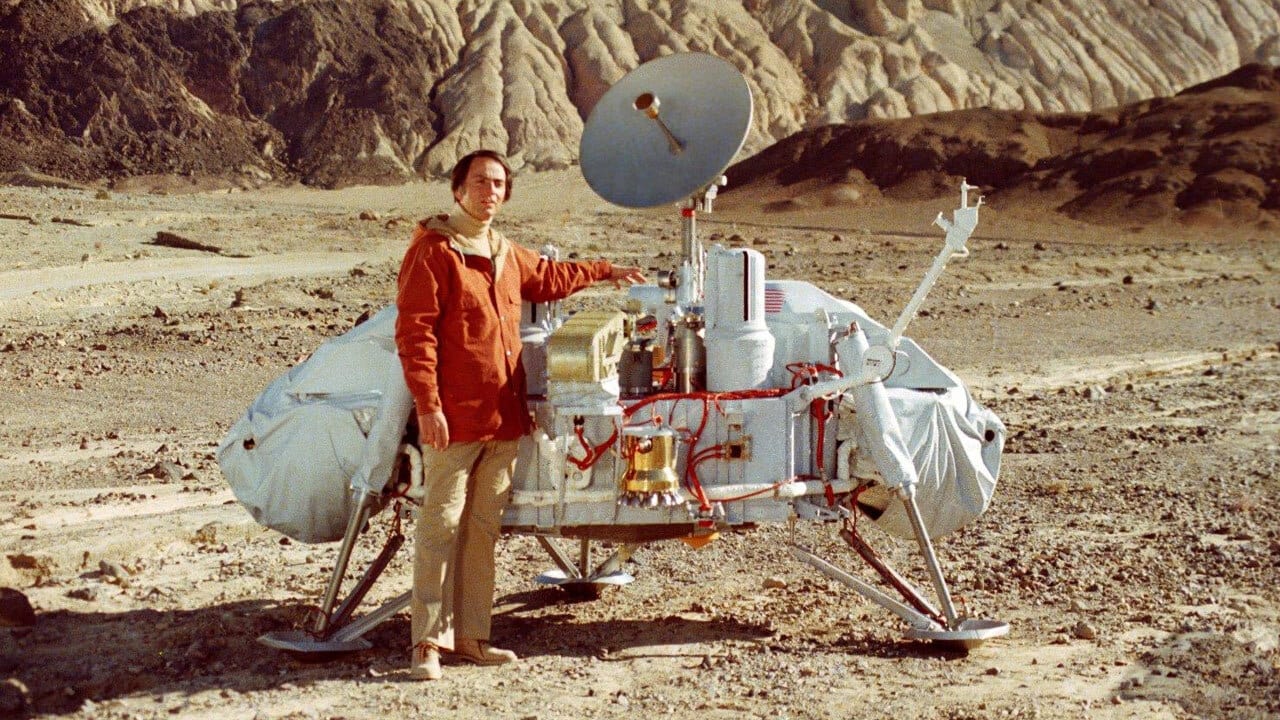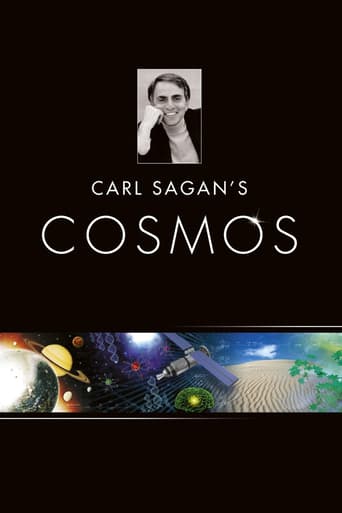

The title of this television science mini series says it all. It presents the cosmos as seen from a wide variety of scientific disciplines to give the television audience a perspective on the universe. Sagan shows the relationships between physics, astronomy, chemistry, and biology to demonstrate how everything in the familiar world came into being. The series is about the universe as well as the rise of sentient beings capable of perceiving it. Re-enactments of key discoveries in science present the viewer with a historical perspective on mankind's quest to understand the universe. Carl Sagan's series uses imaginative tools to illustrate the scale of the cosmos. His journeys in the "Ship of the Imagination" demonstrate the true size of the universe. Similarly, Sagan's "Cosmic Calendar" renders the mind boggling length of time since the beginning of the universe into something more understandable by compressing cosmic history into the more familiar time scale of a single year. Both tools point to the fact that human beings and their planet make up a very small and fragile part of the cosmos.Before this series, there had never been anything quite like it on television. Before "Cosmos: a Personal Voyage," there had been many science documentaries on television; and, some of those programs were excellent. However, most of those series focused on only one aspect of science and sometimes did so in a way which seemed coldly detached. This series was unusual in that it stirred the audience's emotions and inspired a sense of awe. The audience experienced Sagan's fears and hopes for future of the human race as he shared his beliefs that humanity could realize its potential by being vigilant to avoid its self-destructive tendencies. The series is more than an ordinary science documentary but is also the presentation of a vision.This television series is a memorable viewing experience. Carl Sagan is articulate and sometimes poetic in his descriptions of the universe. The combination of Sagan's words as well as the music used in the series create an emotional viewing experience. Although some of the special effects of 1980 are somewhat dated, the visuals in the series are nevertheless stunning; and, most of the information presented in the series has managed to remain relevant in spite of the passing of decades since the series' original broadcast.This series is both awe inspiring and humbling. It provides the viewer with a greater perspective on the universe and the viewers place within it. Ever since the broadcast of this mini series, many other science mini series have attempted to follow in its foot steps; but, no other science series on television has managed to capture the imagination in the way "Cosmos" has. Carl Sagan's science mini series is still the standard by which all others are compared and is highly recommended.
... View MoreCarl Sagan's miniseries about everything that is, ever was, and ever will be is a lot to digest, but you also realize how connected everything is. Whether focusing on the outer reaches of space or the tiniest atom on earth, "Cosmos" lays out our place in the universe. At the same time, Sagan reminds us that our use of technology can either improve our living standard or wipe out all life as we know it. Judging by the present, it's too bad that Sagan isn't around any more. He would be doing more than anyone to counter all the anti-intellectualism promoted by the Tea Party types.A lot of "Cosmos" IS a little hard to follow due to all the scientific lingo, but it's still something that everyone should see to understand our place in the universe, as well as understand what we need to do to preserve our planet.
... View MoreThis 13 episode series written and hosted by the late Carl Sagan, a famous astrophysicist and science popularizer, is in my opinion the best scientific documentary ever made.While scientists will find some information dated, as an introduction to science this is as fascinating as ever. Perhaps the only dated thing, from the presentation side, is the computer graphics used, naturally since this was filmed in 1980, when the field of CGI was just beginning.Among the many issues dealt in the series are the Big Bang, the Milky Way, the life cycle of the stars, the exploration by Voyager of Jupiter's moons, our fascination with and exploration of Mars, the nature of Venus, the search of extraterrestrial intelligence, the strange predictions made by relativity. Sagan scope is so great that two of the thirteen episodes deal more with biology than with astronomy (A voice in the cosmic fugue, dealing with evolution, and the persistence of memory, dealing with the brain).Sagan filmed this in the height of the cold war, at a time when a nuclear war that would devastate the earth was considered possible and even probable, so one of the messages he constantly pounds on is that we live in one planet, and the fate of everyone living here is linked, so the sort of national, religious and ideological divisions that plagued humanity should be a relic of the past, and we need to be able to project a much more global thinking.Besides the documentary aspects, the series also includes some parts with actors playing Sagan's scientific heroes, including Albert Einstein, Johannes Kepler (who discovered the laws of planetary motion), Robert Goddard (a pioneer in space rockets), Jean François Champollion (decipherer of Egyptian hieroglyphics), astronomer Milton Humason (whose discovery of the red shift of the galaxies would eventually pave way for the discovery of the Big Bang), Christian Huygens (a 17th century scientist, representative of the progressive Netherlands of the age of exploration), French explorer Jean de la Perouse and Hypatia (a female astronomer in Roman Alexandria, and one of the last figures of classical antiquity, murdered by a zealous Christian bishop).The terrific soundtrack (mostly by Vangelis, but also with a good dose of classical music) helps a lot.
... View MoreKNOWLEDGE! Not just physics, not just astronomy, not just biology, or philosophy or mathematics; knowledge from every strand of human endeavor. Astronomer Carl Sagan ties it all together in an immense library of congress called COSMOS.First broadcast on Public Broadcasting Service (PBS) in 1980, to date COSMOS is still the most widely watched PBS television series in the world. It won an Emmy and a Peabody Award and was viewed by over half a billion people.Not merely a dry, didactic statement of facts, COSMOS appeals to such a wide audience because Sagan makes every episode, every topic, every nuanced syllable as interesting as possible, using props, special effects, reenactments, shooting on location around the world - the brilliant scientist himself, turtled to the neck, the most interesting prop of all.COSMOS is also an optimistic cry to humanity; an understanding of our place in the universe; a plea that we are all in this together on a small blue rock drifting in an endless ocean of night...It has dated, yes, and the special effects look quaintly chumbly-wumbly (especially the hokey "Spaceship of the Imagination" Sagan supposedly travels the cosmos in), but COSMOS is a perfect example of what the methodology of science is: a continually-changing facility, presenting the facts from evidence gleaned up to that point, but knowing those facts will change with more precise measurements, images, monitoring, researching - and welcoming those changes. No one - not even Sagan himself - would claim this series or his book of the same name was the ultimate be-all and end-all of knowledge (matter of fact, in 2005 The Science Channel rebroadcast COSMOS with updated computer graphics, new satellite photos of our solar system's planets, and digital sound). It was a placeholder until more current facts could be verified about the nature of things.Even so, COSMOS is one helluva placeholder, Sagan bringing together strands of philosophy, sociology and science into a fascinating wrecking ball of entertaining intellectualism.
... View More